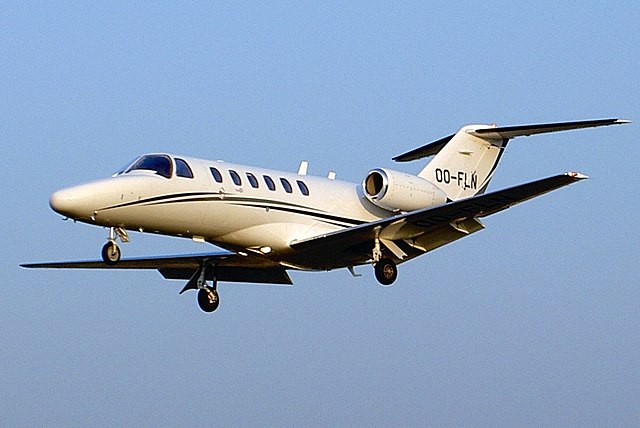Top Qs
Timeline
Chat
Perspective
Williams FJ44
Small turbofan engine From Wikipedia, the free encyclopedia
Remove ads
The Williams FJ44 is a family of small, two-spool, turbofan engines produced by Williams International for the light business jet market. Until the recent boom in the very light jet market, the FJ44 was one of the smallest turbofans available for civilian applications. Although a Williams design, Rolls-Royce was brought into the project at an early stage to design, develop, and manufacture an air-cooled high-pressure (HP) turbine for the engine. The FJ44 first flew on July 12, 1988 on the Scaled Composites/Beechcraft Triumph aircraft.
The Williams FJ33 is a newer, smaller engine based on the basic FJ44 design.
Remove ads
Development
Production started in 1992 with the 1,900 lbf (8.5 kN) thrust FJ44-1A. The FJ44-1C is derated to 1,500 lbf (6.7 kN). The uprated to 2,300 lbf (10 kN) FJ44-2A was introduced in 1997. The 2,820 lbf (12.5 kN) thrust FJ44-3A was introduced in 2004. In 2005, a new low end version, the FJ44-1AP, was introduced, with a 1,965 lbf (8.74 kN) takeoff thrust. Released in 2007 was the new 3,600 lbf (16 kN) thrust FJ44-4. In 2010 this engine was in use on the Cessna CJ4, and since 2018 also on the new Pilatus PC-24.
Remove ads
Design
The FJ44-1A has a single stage blisk fan plus a single intermediate pressure (IP) booster stage, both driven by a 2 stage low pressure (LP) turbine, and supercharging a single stage centrifugal high pressure (HP) compressor, driven by a single stage uncooled high pressure (HP) turbine. The combustor is an impingement cooled annular design. Fuel is delivered to the combustor through an unusual rotating fuel nozzle system, rather than the standard fuel-air mixers or vapourisers. The bypass duct runs the full length of the engine. The FJ44-2A has two additional booster compressor stages.
Remove ads
Variants
- FJ44-1A
- 1,900 lbf (8.5 kN) thrust, production started in 1992, 20.9 in (530 mm) diameter fan, SFC at full thrust at SLS, ISA is understood to be 0.456 lb/(hr lbf),
- FJ44-1AP
- 1,965 lbf (8.74 kN) takeoff thrust, introduced in 2005, 5% better specific fuel consumption, lower internal temperatures, similar to the -1A with a higher pressure ratio fan, a new combustor and LP turbine, a new full length bypass duct/exhaust mixer and a dual channel FADEC.[2]
- FJ44-1C
- 1,500 lbf (6.7 kN) thrust, derated version of the FJ44-1A, SFC of 0.460 lb/lbf/h (46.9 kg/kN/h).[3][4]
- FJ44-2A
- 2,300 lbf (10 kN) thrust, introduced in 1997, larger 21.7 in (550 mm) diameter fan, with two additional booster stages to increase core flow, centrifugal compressor throttled-back aerodynamically to a lower HPC pressure ratio than the -1, exhaust mixer and a fuel electronic control unit.[5]
- FJ44-2C
- 2,400 lbf (11 kN) thrust, similar to the -2A with an integrated hydromechanical fuel control unit.
- FJ44-3A
- 2,820 lbf (12.5 kN) thrust, 2004 introduction, similar to the -2A with a larger fan and dual channel FADEC unit.[6]
- FJ44-3A-24
- 2,490 lbf (11.1 kN) thrust, derated -3A.
- FJ44-3AP
- 3,000 lbf (13 kN) thrust.[7]
- FJ44-4A
- 3,600 lbf (16 kN) thrust, released in 2007, hi-tech fan of larger diameter than the -3 unit.[8] Used on the Cessna CJ4 and the Pilatus PC-24.
- FJ44-4C
- 3,450 lbf (15.3kN) thrust. Used on the upcoming Honda HA-480 Echelon.[9][10]
- FJ44-4M
- Williams-Rolls F129
- Military designation for the derated FJ44-1C with 1,500 lbf (6.7 kN) thrust.
Applications

Remove ads
Specifications
Remove ads
See also
Related development
Related lists
References
Notes
External links
Wikiwand - on
Seamless Wikipedia browsing. On steroids.
Remove ads

